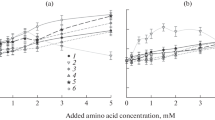Summary
-
1.
Twelve pathogenetic strains of staphylococci survived in 0.9% NaCl according to the density of their suspensions, i.e. the greater the number of germs, the longer the time of survival.
-
2.
Lysates of these 12 strains were mixed with staphylococci. Whereas standard doses of germs in NaCl solution survived 2-3 days only, the same quantity of staphylococci added to these lysates survived up to 4 months. The survival time was found to be directly related to the dilution of lysates.
-
3.
It is possible to keep these bacteria alive in lysates for a long time, if they are transferred in regular intervals to new lysates. The biological properties of the strains did not change.
-
4.
By means of the Warburg apparatus it could be demonstrated that the respiration of the germs suspended in lysates was significantly augmented in comparison to the controls suspended in NaCl solution.
-
5.
All investigations concerning lysates have been performed with isologous and homologous lysates. No differences in the behavior of respiration between isologous and homologous strains in different lysates could be observed.
-
6.
Staphylococci are able to survive over longer periods in a substrate prepared from killed germs of their own.
Zusammenfassung
-
1.
Die Überlebenszeiten (Tage-Monate) von 12 pathogenen in NaCl-Lösung aufgeschwemmten Staphylokokken-Stämmen waren abhängig von der Menge der jeweils verwendeten Keime. Je größer die Keimzahl, desto länger die Überlebenszeiten.
-
2.
In Staphylokokken-Lysaten ergaben sich gegenüber den Kontrollen in NaCl-Lösung (2–3 Tage) Überlebenszeiten bis zu 4 Monaten. Diese Überlebenszeiten sind unmittelbar abhängig von den vorgegebenen Lysat-Konzentrationen.
-
3.
Es gelingt, Staphylokokken in Lysatansätzen bei regelmäßigem Überimpfen in frisches Lysat über sehr lange Zeiträume lebensfähig zu erhalten, ohne daß sich ihre biologischen Eigenschaften ändern.
-
4.
Im Warburg-Apparat war eine deutliche Steigerung der Zellatmung festzustellen.
-
5.
Alle Versuche mit Lysaten sind im isologen und homologen Ansatz geprüft worden. Unterschiedliche Ergebnisse waren dabei nicht zu beobachten.
-
6.
Staphylokokken sind in der Lage, sich ausschließlich mit ihren eigenen Lysaten über längere Zeitabschnitte am Leben zu erhalten.
Similar content being viewed by others
Literatur
Ahn, T. H., Nishimura, H., Carpenter, C. M., Taplin, G. V.: Viability and metabolism of Staphylococcus aureus after freezing, lyophilization and irradiation. J. Bact.88, 454–552 (1964)
Cohen, J. O.: The staphylococci. New York: Wiley Interscience 1972
Fujikura, T., Shibata, S. H.: Enhancing effect of sonicated staphylococcal filtrate on the colony formation from cattle. Nat. Inst. Hlth Bull.6, 184–185 (1966)
Grün, L.: Staphylokokken in Klinik und Praxis, S. 94–95. Stuttgart: Wiss. Verlagsges. 1964
Huff, E., Oxley, H., Silverman, C. S.: Density gradient patterns of Staphylococcus aureus cells and cell walls during growth and mechanical disruption. J. Bact.88, 1155–1162 (1964)
Merkenschlager, M., Schloßmann, J., Kurz, W.: Ein mechanischer Zellhomogenisator und seine Anwendbarkeit auf biologische Probleme. Biochem. Z.329, 322–340 (1957)
Paetzold, O.-H.: Untersuchungen über die bakteriellen Verunreinigungen von Externa. Therapiewoche21, 2840–2846 (1971)
Parfentjew, I. A., Catelli, A. R.: Tolerance of Staphylococcus aureus to sodium chloride. J. Bact.88, 1–3 (1964)
Pettit, F., Lowbury, E. J. L.: Survival of wound pathogens under different environmental conditions. J. Hyg. (Lond.)66, 393–406 (1968)
Ruge, H. G. S.: Unveröffentlichte Mitteilungen an A. Proppe, Kiel (1965)
Author information
Authors and Affiliations
Rights and permissions
About this article
Cite this article
Ruge, H.G.S., Paetzold, O.H. & Wiese, A. Das überleben von staphylokokken im eigenen lysat. Arch. Derm. Res. 247, 387–398 (1973). https://doi.org/10.1007/BF02449869
Received:
Issue Date:
DOI: https://doi.org/10.1007/BF02449869




